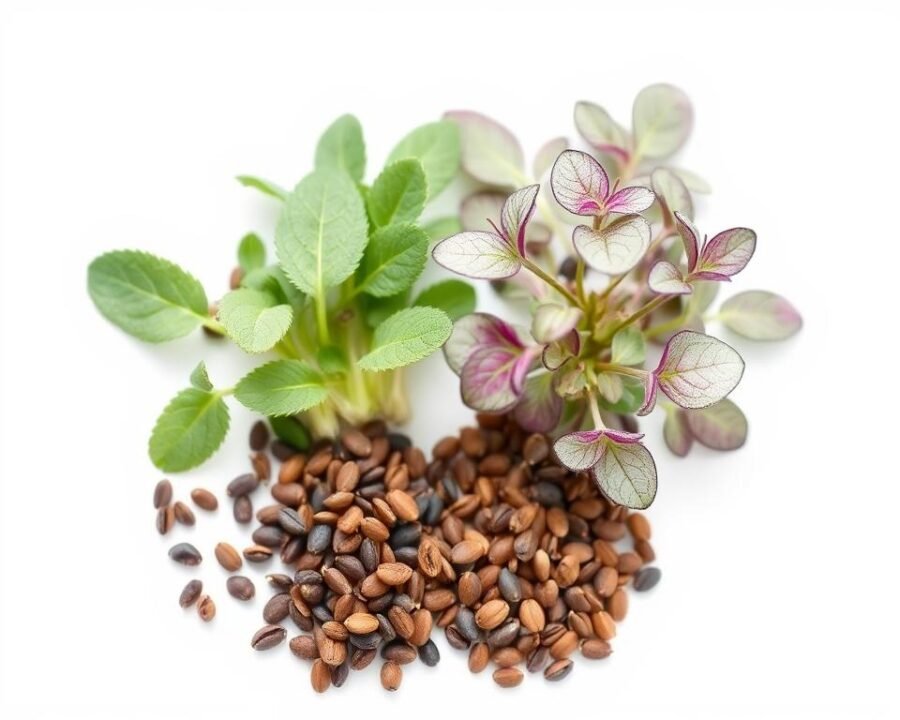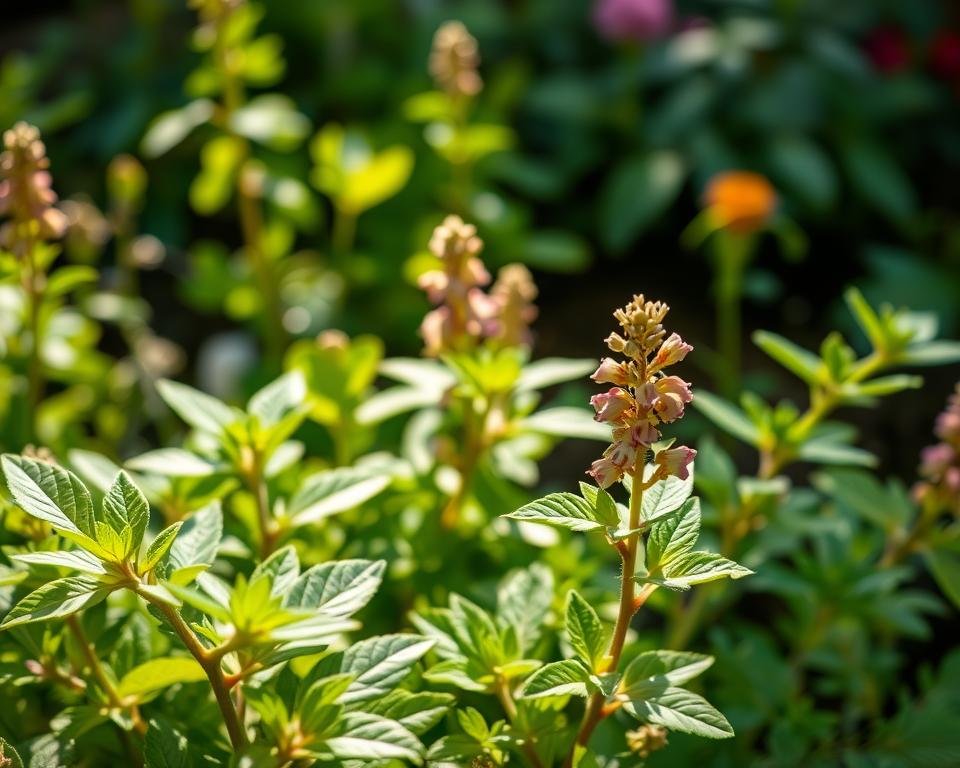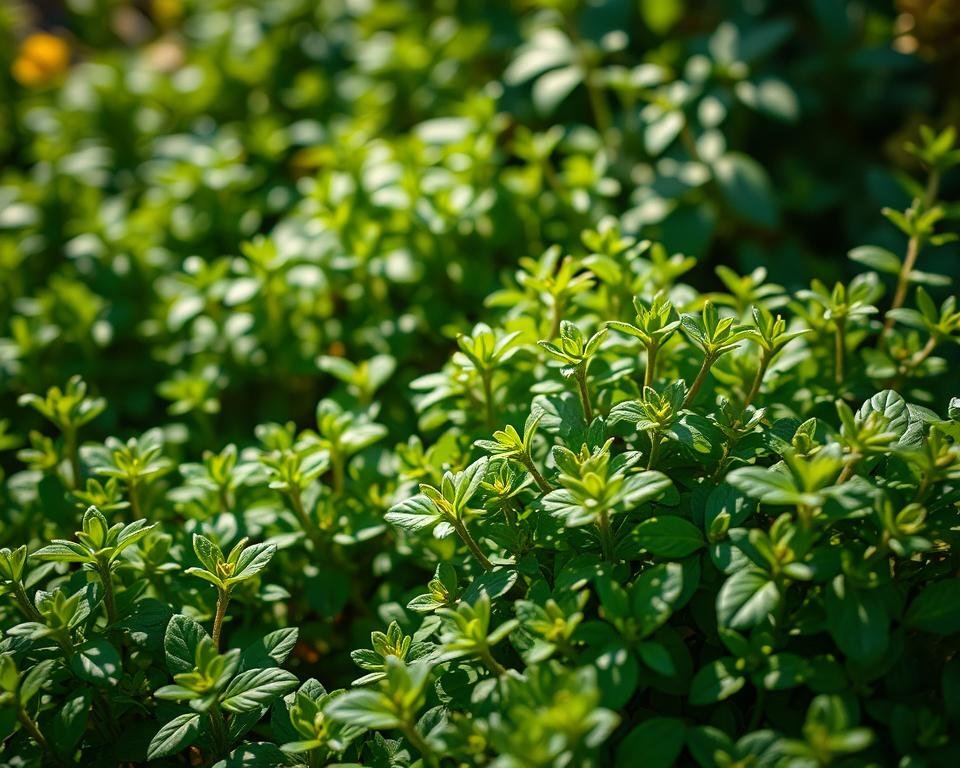There’s something magical about stepping into a garden and plucking fresh oregano leaves. The earthy aroma instantly transports you to sun-drenched Mediterranean kitchens. Whether sprinkled over pizza or steeped in tea, this herb adds a burst of flavor to every dish.
Native to warm climates, oregano thrives in full sun and well-draining soil. Its hardy nature makes it perfect for beginners and seasoned gardeners alike. Unlike its sweeter cousin marjoram, this plant packs a bold, peppery punch.
From borders to containers, oregano adapts effortlessly. Pollinators love its tiny blooms, and you’ll adore its year-round harvest potential. Ready to bring this versatile herb into your space? Let’s dive in.
Key Takeaways
- Oregano is a drought-tolerant perennial suited for USDA zones 5–10.
- It thrives in full sun and requires minimal watering once established.
- The herb’s compact growth (up to 30cm) works for gardens or containers.
- Its leaves offer a stronger flavor compared to marjoram.
- Trailing varieties make excellent ground cover or edging.
Why Oregano Is a Must-Have Herb for Your Garden
Few herbs pack as much punch in both flavor and function as oregano. Whether dried or fresh, its bold taste elevates meals, while its hardy nature supports gardens effortlessly. Let’s explore why this Mediterranean native deserves a spot in your space.
Versatile Uses in Cooking
Oregano’s leaves transform ordinary dishes into vibrant creations. The Royal Horticultural Society notes its starring role in pizza and pasta sauces, with dried leaves offering concentrated flavor. Bonnie Plants suggests tossing fresh sprigs into meats or eggs just before serving.
- 25+ culinary uses: Rubs, marinades, infused oils, and salads.
- Dried vs. fresh: Phenolic compounds intensify when dried.
- Freeze-drying hack: Preserves peak flavor for year-round use.
“Oregano’s flowers aren’t just pretty—they’re edible. Toss them in salads for a peppery kick.”
Benefits for Pollinators
From July to September, oregano’s pink and white flowers become a pollinator magnet. Bees and butterflies flock to their nectar-rich blooms, boosting local ecosystems. Even the stems add texture to garden designs.
Low-Maintenance Perennial
This herb thrives on neglect. It survives 5°F winters with proper drainage and rebounds each spring. Arizona gardener Angela Judd proves its resilience—her 2019 plant still flourishes with biannual pruning.
- Drought-resistant: Ideal for water-wise gardens.
- Container-friendly: Whiskey barrels or window boxes work.
- Companion plants: Pair with thyme or sage for a Mediterranean vibe.
Choosing the Best Oregano Variety for Your Needs
Not all oregano types are created equal—some dazzle in dishes, while others shine in landscapes. The right pick depends on your climate, cooking style, and garden space. Let’s explore the top options.
Popular Culinary Varieties
Greek and Italian oregano dominate kitchens for their bold, peppery flavor. Syrian varieties add citrusy notes, perfect for marinades. Check the table below for quick comparisons:
| Variety | Flavor Profile | Best Uses | USDA Zones |
|---|---|---|---|
| Greek | Strong, earthy | Pizza, roasted meats | 5–10 |
| Italian | Mildly sweet | Pasta sauces, soups | 6–11 |
| Hot & Spicy | Fiery kick | Chilis, rubs | 7–10 |
“Always crush a leaf before buying transplants. Strong aroma means potent flavor in your dishes.”
Ornamental vs. Edible Types
‘Kent Beauty’ dazzles with trailing stems but lacks culinary value. The Royal Horticultural Society warns against confusing ornamental types with edible ones. Mint-family lookalikes may disappoint in recipes.
Climate Considerations
In Zone 7+, afternoon shade prevents leaf scorch. Humid regions need disease-resistant cultivars like ‘Bonnie’s Best’. For container gardening, compact varieties like ‘Compactum’ thrive on patios.
- Cold-hardy picks: ‘Greek’ survives frosts down to 5°F.
- Heat lovers: ‘Italian’ excels in Phoenix’s arid summers.
- Humidity fix: ‘Syrian’ resists mildew in southeastern states.
How to Grow Oregano Herbs Plant Everyone Is Using
Fresh oregano starts with smart planting choices—seeds or transplants set the stage. Each method suits different climates and patience levels. We’ll guide you through timing, containers, and foolproof techniques.

Seeds vs. Transplants: Which Wins?
Starting from seed offers variety but demands patience. The RHS recommends sowing indoors at 15°C (60°F) for even germination. Expect 60% success rates—thin weak sprouts early.
Transplants jumpstart growth. Angela Judd notes they thrive when soil tops 70°F. Harden them off over 7 days before moving outdoors. Success rates soar to 95% with proper care.
| Method | Time to Harvest | Best For | Tips |
|---|---|---|---|
| Seeds | 12–14 weeks | Budget gardeners | Use heat mats for faster sprouting |
| Transplants | 6–8 weeks | Immediate results | Choose compact, pest-free stems |
Timing Is Everything
Plant after the last frost in cooler zones. Bonnie’s data shows zones 8–10 can plant year-round. Follow this USDA zone schedule:
- Zones 5–7: Mid-spring (soil workable)
- Zones 8–10: Fall or early spring
- Indoors: Start seeds 8 weeks before the last frost
Containers Made Simple
Oregano thrives in pots. Bonnie insists on 12-inch depths for root space. Angela’s whiskey barrel proves durability—her 2019 plant still flourishes.
Compare materials:
- Terra cotta: Breathable but dries fast
- Plastic: Retains moisture, lightweight
- Fabric: Prevents root rot, foldable for storage
“Mix 2 parts potting soil with 1 part perlite for ideal drainage. Oregano hates wet feet!”
Preparing the Perfect Growing Environment
Healthy oregano begins with the right foundation—soil, sunlight, and space. Replicating its native Mediterranean conditions ensures vibrant flavor and vigorous growth. Let’s break down each element for success.
Soil Requirements and Amendments
Oregano demands well-draining soil with a pH of 6.5–7.0. Bonnie Plants recommends mixing in compost for nutrients. For pots, the RHS suggests adding 25% grit to prevent waterlogging.

Test your soil with a kit. Sandy blends work best in arid zones like Arizona. In humid areas, raised beds combat root rot. Try this DIY mix:
- 3 parts potting soil
- 1 part coarse sand
- 1 part compost
Sunlight Needs
This herb thrives in full sun (6+ hours daily). In Zone 7+, afternoon shade prevents leaf scorch. Urban gardeners can use reflectors to maximize light.
Track exposure with a sun calculator. Angela Judd notes her low-desert plants flourish with morning sun and filtered afternoon rays.
Spacing for Optimal Growth
Give plants room to breathe. The RHS advises 20–30cm between garden plants. Bonnie’s research shows 8–10 inches boosts air circulation.
In pots, aim for 12-inch diameters. Trailing varieties like ‘Kent Beauty’ need extra space. Companion planting? Keep tomatoes 18 inches away.
“Gravel mulch beats bark in dry climates—it reflects heat and wards off slugs.”
Essential Oregano Care Tips
Keeping oregano thriving requires simple but crucial care steps. With the right routine, your plants will reward you with bold flavor and lush leaves. Let’s dive into watering, pruning, and seasonal protection.

Smart Watering Practices
Oregano prefers dry feet. Bonnie Plants advises watering only when the top inch of soil dries out. In Arizona, Angela Judd’s weekly deep watering keeps plants hydrated without overdoing it.
Compare methods:
- Deep watering: Encourages strong root growth.
- Light sprinkling: Risks shallow roots and mold.
“A $20 moisture meter eliminates guesswork—aim for 50% dryness before watering.”
Pruning for Prosperity
Trim stems by one-third in spring to encourage bushiness. Post-bloom cuts keep leaves tender. Always sterilize shears with rubbing alcohol to prevent disease.
Key techniques:
- Cut above leaf nodes for regrowth.
- Remove woody stems to redirect energy.
Winter Protection Strategies
In zones below 5, shield plants from frost. The RHS recommends 2–4 inches of mulch. For pots, wrap with bubble wrap or move indoors.
Pro tips:
- Use cloches with ventilation holes.
- Angela’s chicken coop heater hack wards off freezing temps.
Common Oregano Problems and Solutions
Even the hardiest oregano can face challenges—here’s how to tackle them. From sneaky pests to stubborn diseases, quick action keeps your *plants* flourishing. We’ll cover prevention, fixes, and revival tricks.
Pest Prevention Tactics
Aphids love tender *foliage*, but garlic spray sends them packing. Bonnie Plants recommends neem oil for spider mites—apply every 7 days. Companion planting with marigolds adds extra protection.
| Pest | Signs | Solution |
|---|---|---|
| Aphids | Sticky *leaves* | DIY garlic spray (1 crushed bulb + 1 quart water) |
| Spider Mites | Webbed *stems* | Neem oil (2 tbsp/gallon) |
| Mint Moths | Holes in *foliage* | RHS-approved ladybugs |
Disease Management
Rust fungus thrives in humid *conditions*. The Royal Horticultural Society advises spacing *plants* 12 inches apart for airflow. For root rot, Angela’s chart says: “Brown roots? Reduce *water* and repot in dry *soil*.”
- Fungicide rotation: Copper spray (Week 1), sulfur (Week 3).
- Soil drenching: Works better than foliar sprays for deep infections.
Reviving Struggling Plants
Wilting *plants*? Try Bonnie’s seaweed extract soak. For root-bound *pots*, gently tease roots apart before repotting. Angela’s ICU protocol:
- Trim dead *growth*.
- Soak roots in compost tea.
- Move to shade for 48 hours.
“Hydroponic systems rescue dying oregano fast—just add oxygenated water and watch for new *leaves* in 5 days.”
Harvesting and Preserving Your Oregano
Timing and technique make all the difference when gathering your harvest. With the right approach, you’ll lock in that signature flavor for months to come. Let’s explore the best ways to pick, dry, and store this versatile herb.
Optimal Harvesting Techniques
For peak flavor, the Royal Horticultural Society recommends picking leaves just before flowering. Mid-summer mornings deliver the highest oil content in stems. Use sharp scissors to avoid damaging the plant.
- Morning cuts: Essential oils concentrate after dew evaporates.
- Pinch test: Leaves should spring back slightly when ready.
- Continuous harvest: Encourages bushier growth.
“Bundle 5-6 stems with rubber bands for air-drying. Darkness preserves that bold flavor best.”
Drying Methods Compared
Air-drying works beautifully for whole stems. Hang bundles upside down in a warm, dry spot for 1-2 weeks. For faster results, try a dehydrator at 95°F (35°C) for 4-6 hours.
| Method | Time | Flavor Retention |
|---|---|---|
| Air-drying | 7-14 days | 90% carvacrol preserved |
| Dehydrator | 4-6 hours | 85% carvacrol preserved |
| Oven-drying | 2-4 hours | 75% carvacrol preserved |
Freezing for Freshness
Ice cube trays transform leaves into ready-to-use portions. Blend with olive oil before freezing for instant pasta boosters. Freeze-dried pesto keeps its vibrant color for up to 12 months.
- Whole-leaf freezing: Spread on trays before bagging.
- Oil infusion: Extends shelf life to 18 months.
- Vacuum sealing: Prevents freezer burn effectively.
Whether sprinkled on salads or simmered in dishes, preserved oregano brings Mediterranean sunshine to winter cooking. With these methods, your harvest will flavor meals for years.
Conclusion: Enjoy Your Homegrown Oregano All Year
Your journey with this versatile herb doesn’t end at harvest—it’s just the beginning. From sprouting seeds to robust plants, each phase brings rewards. Those fragrant leaves now flavor your favorite dishes, saving you trips to the store.
Try air-drying bundles or freezing leaves in oil. Experiment with pizza sauces or infused vinegars. Over years, your garden becomes a self-renewing spice rack.
Angela’s thriving patch proves even novices succeed. Need help? Bonnie’s team and RHS guides offer expert tips. Ready for advanced projects? Oregano oil extraction awaits.
Now, step outside—your garden buzzes with grateful pollinators. Every snip of oregano celebrates your green thumb. Happy growing!
